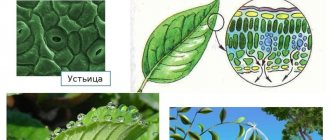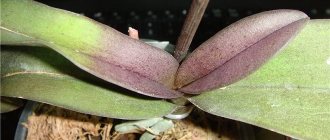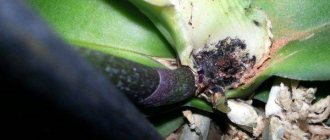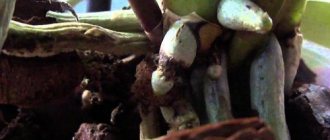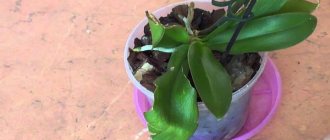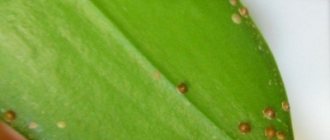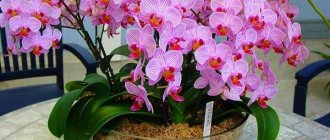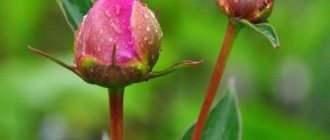Beginning gardeners are afraid to have orchids at home. They believe that these plants are too capricious, prone to disease and cause a lot of trouble. Meanwhile, the vast majority of problems arise only due to violation of the content rules. It is the errors made during care that cause sticky drops to form on the orchid leaves. Do you want to know why they appear and how to deal with them? Read on and get comprehensive answers.
There are sticky drops on the orchid leaves, what should I do?
There are many reasons for the appearance of sticky drops on the leaves of the phalaenopsis orchid and other types of orchids. The most common include pest damage or disease. This may also be due to improper care of the flower.
Natural process
In a plant crop, the process of moisture movement throughout the plant occurs regularly; flower growers call it transpiration. During this process, evaporation is formed in the form of droplets on the leaves. This phenomenon in itself is safe and does not pose any threat to the full development of the orchid. However, the following negative consequences may occur:
- the appearance of ants that gather for sweet nectar;
- appearance of various insects.
In most cases, pests stick to the sticky droplets and die. Many of them are put off by the overly sweet smell.
Excessive watering
The formation of sticky drops on orchid leaves can also be a consequence of improper care. If you irrigate a plant too often or abundantly, excess liquid accumulates on its green mass, gradually this substance becomes sticky.
Excess moisture that has accumulated in the pan also evaporates and settles on the leaves of color. All this negatively affects the condition of the plant - it begins to wither and fade. Therefore, the watering regime should be normalized.
On a note! During the active growth phase, it is recommended to irrigate Phalaenopsis once every 5-7 days, and during flowering and during the dormant period once every 8-10 days.
Excess fertilizing
Due to excessive fertilization, the orchid's metabolism increases significantly. As a result, internal nectar begins to be actively released, which subsequently settles in the form of sticky droplets. Overfeeding leads to the following negative consequences:
- phosphorus;
- potassium;
- nitrogen.
In the future, the plant crop will begin to fade. The leaves will dry out and spots will form on them. To save it from death, you need to completely replace the soil in the pot and give it a break from fertilizers for a while.
Pest infestation
One of the most common reasons why sticky drops form on orchid leaves is pest damage. Most dangerous for the orchid:
Shield. After defeating a plant, this insect creates a dome of wax above itself. It is often confused with sticky droplets. But, if you look closely, you will notice traces of damage in the form of small holes.
Scaleworms. When eaten, this type of pest sucks out the inner juice from the leaves, then injects its poison there. In appearance, they look like small white lumps with a waxy surface. It is for this reason that it is quite easy to confuse it with sticky droplets.
Spider mite. Due to the infestation of this insect, a white coating forms on the leaves, which subsequently condenses into moisture.
If pests have formed on the surface of the green mass of the orchid, immediate measures must be taken to eliminate them. Otherwise, the plant crop may die.
Powdery mildew
The most common disease to which Phalaenopsis is susceptible is powdery mildew. It can be recognized by several characteristic features:
- the appearance of multiple small sticky droplets;
- the formation of white plaque, which subsequently darkens;
- drying of damaged areas.
In most cases, powdery mildew is a consequence of high levels of humidity and temperature in the room, and excessive watering. If you do not start treating the disease in a timely manner, the plant will die.
Photo
In the photo below you can see what an orchid that is covered with a white coating looks like:
This is a photo of sticky droplets on the leaves:
These photos show white sticky spots:
How to identify the cause?
The first thing to do is to identify the cause of the formation of sticky plaque on the orchid leaves. Based on this, you can choose the most suitable method to solve the problem.
Signs of a natural process
If the droplets appeared as a result of natural movement and evaporation of moisture, then there should be no associated symptoms of the disease or signs of damage. No special actions are required, you just need to normalize the watering regime and monitor the condition of the plant.
Signs of improper care
The reasons why the orchid’s leaves have become sticky include violations of the rules for caring for it, namely:
- increased or decreased humidity level in the room where the flower grows;
- any draft near the plant - an open window or front door;
- low air temperature;
- improper lighting - too bright or, on the contrary, insufficient.
In addition to the formation of moisture, signs of violation of plant growing conditions include:
- slow development;
- lack of flowering;
- wilting of leaves;
- the appearance of a light coating.
The problem can be corrected by normalizing the care and watering regime.
On a note! The optimal air temperature for growing orchids is from 18 to 25 degrees Celsius. However, when flowering or during a period of active growth, it needs coolness, so the optimal air temperature should be from 12 to 16 degrees.
Signs of a pest infestation
You can recognize that a plant crop has been damaged by pests by several characteristic symptoms:
- sticky drops;
- white coating;
- traces of eating;
- wilting of leaves.
At first glance, these sticky drops can be confused with insect pests. They can only be recognized with a magnifying glass.
Why are the leaves sticky on the bottom?
If sticky drops appear on the underside of the orchid leaves, the reason may be due to the appearance of aphids. Most often, they colonize the back side of the green mass, and when infected, they secrete a characteristic sugary liquid.
Preventive measures
To ensure protection against possible diseases, optimal conditions for keeping the orchid should be created. Prevention against infections:
- The substrate for planting orchids must be checked for the presence of insects and disinfected.
- In winter, it is necessary to maintain the temperature at +16...+18 °C, in summer +22...+25 °C.
- The humidity level should not exceed 60-70%.
- The room in which the plant is located must be constantly ventilated.
- The flower is watered 1-2 times every 10 days, the leaves are sprayed with water daily. The number of waterings is determined depending on the humidity of the substrate. Use separated water. Water should not be allowed to stagnate in the axils of the peduncles.
- During the flowering period, the orchid needs iron and potassium. It is fed 2 times every 30 days with fertilizer containing these minerals.
- Instead of fertilizers, you can use homemade vitamin cocktails. Thanks to them, the plant will begin to develop more actively and harmoniously. A cocktail containing B vitamins, glucose and succinic acid will make it easier to endure various diseases, unscheduled transplants and other difficulties.
If you constantly maintain the temperature at the desired level, avoiding sudden changes and drafts, and check the plant for pests, the flower will not need complex treatment. It is considered normal when sticky drops appear on the plant after each watering.
How to eliminate the consequences of improper care?
A frequently asked question is what to do if there are sticky droplets on the orchid? Experienced flower growers recommend, first of all, neutralizing the consequences of improper plant care. You can do this as follows:
- It is necessary to rinse the leaves with running water. If possible, rinse the pot and change the soil. After this, it is necessary to reduce the amount of irrigation if the soil was previously waterlogged.
- If there is a low level of humidity in the room, most often this is observed in the summer season, it is recommended to spray with warm water with the addition of a few drops of fungicide.
- Normalize the lighting mode. It is better to grow an orchid on a windowsill, but at the same time it should not be exposed to direct sunlight. It is also necessary to avoid drafts.
If the appearance of a sticky coating is a consequence of improper care, it must be eliminated. To do this, it is enough to treat the plant with warm or hot water from the shower. Firstly, during this procedure it will be possible to get rid of sticky drops. Secondly, it will be possible to prevent stagnation of moisture in the axils of the leaves.
Analytics: Which method of removing plaque is better?
The editors of the 32-top website compared plaque cleaning at home and in the dentist's chair and highlighted the advantages and disadvantages of these methods.
Cleaning plaque at home
Advantages:
- Very low cost;
- Does not require visits to the doctor, can be done at home;
- Doesn't take much time;
- Suitable for those who are afraid of dentists.
Popular articles Jasmine Sambac: care at home
Flaws:
- Not very effective;
- Some areas of the teeth are difficult to reach, and plaque from them cannot be easily removed;
- Cleaning with certain products, such as baking soda or peroxide, can damage the enamel.
Dental floss
Professional cleaning at the dentist
Advantages:
- Very effective, allows you to completely get rid of plaque;
- Teeth become noticeably lighter;
- Safe for enamel.
Flaws:
- Higher cost;
- Takes longer due to the need to visit a doctor.
IMPORTANT: As a result, we can conclude that home cleaning is a temporary measure for very busy people. It is better to allocate time and money at least once a year and visit the dentist for professional cleaning
Methods of treating plants depending on the cause
Treatment for sticky orchid leaves depends on the cause of their appearance. If it is associated with insect damage, then the following must be done:
- Place the Phalaenopsis pot away from other plants to prevent the risk of infection.
- Carefully remove pests. You can use a soft cloth or cotton swab for this purpose.
- If the leaves are severely affected, they should be cut off.
- Pass a piece of soap through a grater or divide it into small pieces. Dilute it in warm water and stir until a homogeneous consistency is formed. Rinse the plant with the resulting solution, including those areas where there are no traces of eating by insects.
If the flower is severely affected, then it must be treated with a special insecticide solution. You can buy it in stores for summer residents and gardeners. It is recommended to dilute in accordance with the instructions.
What to do if sticky drops and white coating appear on the orchids? Flower growers claim that this is due to powdery mildew, so the treatment should look like this:
- It is necessary to place the flower in the bath and rinse it with warm water under running water or shower.
- Leave to dry for 12-14 hours.
- Treat with a fungicide solution. The most effective is "Aktar" or "Aktellik". It is necessary to prepare and apply it in accordance with the instructions.
- Disinfect the new container. Fill it with disinfected soil. Transplant a flower into it.
Immediately after transplanting, it is recommended to reduce the amount of watering to once every 5-8 days. It is also not recommended to apply fertilizers during the year.
It is important that after treatment the plant is quarantined away from other plant crops for another 2-3 weeks. Before moving it back, you need to make sure there are no pests or signs of disease.
On a note! If the formation of sticky plaque is natural, then there is no need to eliminate it.
Diagnostics
The success of treatment depends on the correct diagnosis of the phenomenon, therefore, before starting measures to restore the health of the flower, it is necessary to conduct a thorough visual inspection:
- If on the leaves of phalaenopsis, in addition to the sticky layer, there is also a white coating or black spots, this is a sign of powdery mildew.
- Yellow spots on the leaves indicate an excess of mineral fertilizers.
- It is also necessary to inspect the reverse side of the sheet. If the reason for the appearance of sugar drops lies in insect pests, that’s where you need to look for them.
Preventing sticky drops
It is impossible to prevent the appearance of a sticky coating on the leaves of orchids, since this is often a consequence of the natural internal movement of moisture. However, it is recommended to follow preventive measures that will avoid the appearance of unfavorable drops on the green mass, these include:
- Proper watering. You can tell that it’s time to moisturize by looking at the gray roots. Also, with a lack of moisture, condensation stops appearing on the inside of the pot. It is also worth considering that the liquid should be warm and soft.
- Choosing a location. The orchid should be exposed to diffused light. In the shade, the plant will not be able to grow fully, and exposure to the sun’s rays will cause burns on its green mass.
- Feeding. It is recommended to carry it out only during the vegetative growth of the plant crop. For this purpose, it is better to use specialized complex fertilizers suitable for a specific type of orchid.
You should also constantly monitor the appearance of the orchid. If signs of disease or pest damage appear, immediate measures must be taken to treat it.
Preventative measures to prevent the flower from becoming covered with white fluff
In order to avoid such problems with your orchid, you should follow some preventive measures:
- Water the orchid only when the soil is completely dry.
- Periodically give the flowers a warm shower to remove excess moisture from the leaf plates.
- When temperatures drop, reduce the amount of watering.
- When daylight hours are shortened, use phytolamps.
- Observe temperature conditions.
- Carry out preventive treatment once every three months.
- Replant orchids only in proven soil.
Rate this post
Features of caring for the affected plant
Treatment of sticky drops on orchid leaves also requires appropriate care, which boils down to the following:
- placing the plant crop in a quarantine zone for at least 2-3 weeks;
- treatment with soap solution or specialized preparations;
- creating optimal conditions for growth.
If the plant has been severely damaged, it is additionally recommended to feed it with a preparation such as Zircon or Epin.
